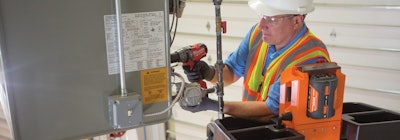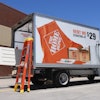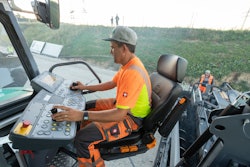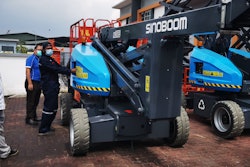
This article was adapted from its original version, "Work More Efficiently With the 10 Basic Principles of Ergonomics," on the JLG blog with permission from the company. The piece was written by the team at JLG and edited by Alexis Brumm for the Rental website.
Whether you work seated or standing, these 10 basic principles of ergonomics can help you evaluate the tasks you do every day and make simple changes that make a big impact. Although the principles of ergonomics are most often applied to work environments, you can also use them at home, in your car, or on the go to improve your overall well-being.
1. Work in a neutral position.
Whether you work sitting or standing and moving throughout the day, it’s important to keep your body in a neutral posture. There are several areas of the body that this principle commonly affects. The first is the back. A healthy spine follows an S-curve, and it’s important to maintain this curve while working to avoid strain on your back. If you work in a seated position, good lumbar support is key. For those who stand or move around a facility, it can be helpful to place one foot up on a footrest when standing still, and when you need to lift something, make sure you lift from your legs rather than from your back.
Other areas of the body that may be out of alignment are the neck, elbows, and wrists. To reduce strain on these areas and keep them in alignment, try adjusting your equipment or work position to keep your muscles in a more relaxed position.
2. Decrease the need for excessive force.
Imagine a time when you had to use your full body weight to move an object. That’s what this principle is referring to. Pushing, pulling, and lifting heavy items can strain your joints, creating the potential for fatigue or injury. Rather than using excessive force, try to identify tools or strategies that can lighten the load you need to move. It may be as simple as using a cart or hoist to move heavy items, or you may need to make changes to your workflow to lessen the distance you need to travel or the number of items you need to transport.
3. Keep materials within easy reach.
Try extending your arms and outlining a semicircle in front of you. This is your reach envelope, and items you use frequently should be inside this semicircle at your workstation. To accommodate your reach envelope, you may need to rearrange your area so you’re no longer reaching for frequently used items. Adjusting your seat and armrests can also bring things like machine controls within reach to reduce fatigue.
This principle also applies when reaching into boxes or bins. Rather than straining your shoulders to reach higher, simply tilt the box or place it on a lower surface before reaching inside.
4. Work at the proper height.
Having a work surface that’s too high or too low can strain the back, neck, and shoulders. Most routine work should be done at elbow height whether you’re sitting or standing. However, if you work with heavy tools, you may want to adjust your position so you’re working lower than elbow height. And on the opposite side, precision work may require you to work at heights above the elbow.
5. Reduce unnecessary motions.
Manual repetition can cause overuse injuries, so it’s important to think about the motions you repeat throughout the day and find ways to reduce excessive motion. For example, rather than twisting your wrist to turn a screwdriver, is it possible to replace the screwdriver with a drill that will take the manual motion out of the task altogether? You can also look for opportunities to change your position or the layout of your work area to help you work more ergonomically.
6. Minimize fatigue caused by static load.
At your job, there may be tasks that require you to hold the same position for an extended period, which is known as static load. Static load can affect all parts of the body, such as the legs when standing for a long time or the shoulders when you need to hold your arms overhead for longer than a few seconds. These types of task can make your muscles tired and may eventually cause lasting discomfort even after the task is finished. Some ways you may be able to combat the fatigue caused by static load are to change the orientation of your work area, reposition your body, or even add extenders to your tools.
7. Minimize contact stress.
Contact stress occurs when a tool or surface routinely comes into contact with the same area of your body. Sometimes called pressure points, these areas of contact can cause discomfort. One example of contact stress is when you routinely squeeze a tool, like pliers, or hold a heavy item, like a nail gun, that puts pressure on an area of your hand. Adding padding, wearing gloves, or choosing tools with a cushioned grip can help. You may also consider adding anti-fatigue mats to standing surfaces to help alleviate contact stress on your heels.
8. Leave adequate clearance.
This principle is very simple—you need to have enough room for your head, knees, and feet. If you work in a seated position, adjust your seat to give yourself adequate legroom. Remove overhead obstructions to avoid bumping your head. Visibility also comes into play here. It’s important that no matter where you’re working or what equipment you’re using, you have a clear view of what’s going on around you.
9. Move and stretch throughout the day.
Staying in one position too long—whether sitting or standing—isn’t healthy for the human body. Take breaks to exercise or stretch your muscles. If you sit for a long time, periodically find time to pause what you’re doing and walk around. If you’re on your feet all day, wear supportive footwear and use your breaks to rest. And if your job is physically demanding on certain parts of your body, it may help to stretch before jumping into strenuous tasks.
10. Keep your environment comfortable.
Work environments vary greatly depending on your industry and role, but some common items you may want to pay attention to are lighting, temperature, vibration, and noise. Look for ways to reduce glare or provide better lighting in low-light areas. Keep work areas at a comfortable temperature when possible, and when you’re working outdoors, dress appropriately for the weather. And if tools create excessive noise or vibration, provide hearing protection and consider ways to dampen vibrating tools.





















